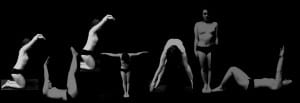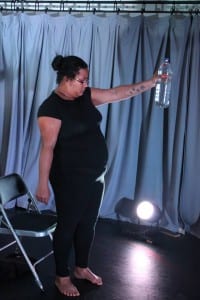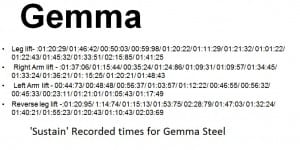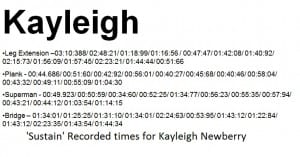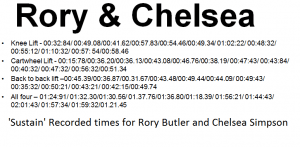Sustain: A Site-Specific Performance exploring the battle of muscular resistance against the force of gravity.
For our Site-Specific performance we chose to explore the affects that the force of gravity would have on the human body when faced with physical exercise being sustained over a period of time. Our performance took place on Saturday 10th May in Studio X, at the Lincoln Performing Arts Centre, from 14:30pm until 20:00pm. Each member of our group had a specific set of tasks or exercises to complete within the allotted time, each exercise was to be sustained for as long as possible before the muscles within the body could no longer battle against the gravity acting upon them, all exercises once complete, were then repeated in the hopes of beating the previous recorded time. Gemma Steele completed four exercises (Right-Arm Sustained Lift, Left-Arm Sustained Lift, 2-Leg Lift, and Rear-Leg Lift) using a two-litre bottle of water to act as a weight to be sustained for as long as physically possible. Kayleigh Newberry also completed four floor/chair-based exercises (Leg Hold, Superman, The Plank, The Bridge), each exercise was sustained for as long as possible, and eventually were extended in differing ways to test the sustainability of Kayleigh’s strength. The final two performers, Chelsea Simpson and I, delivered four lifts (Knee-Lift, Cartwheel Lift, Back-to-Back Lift, and All-Four Lift), each lift was executed and sustained according to the Pilates instruction we undertook in preparation. All exercises were timed and recorded.
From ‘Defying Gravity’ to ‘Sustain’: A development process for Site-Specific Performance
In order to consider the extent by which we as a group developed our work it is first important to not our initial aim was as follows: It is suitable to recognise this project as an opportunity to stretch the transferability of performance into other industries, creating a fluidity; a clean transition , crossing the boundaries or limitations separating Performance and Science through interdisciplinary or multidisciplinary means; that is to suggest an integration of knowledge and methods from different disciplines by means of a pre-conceived synthesis approach or indeed individuals of differing disciplines drawing on their disciplinary knowledge forming into a pseudo-amalgamation of vision or perhaps of a development of a ‘bank of knowledge’.
The foundational dynamics of our concept for Site-Specific centred solely on the limitations within performance, and how implementing a pseudo “experiment” i.e. the effects of gravity on the human body and sustaining weight over a period of time, encapsulated the idea that as humans we are limited and defined by the external effects of science and force. Placing this concept within a performative manner was initially established on the foundations of reflection and visual trickery to remove the visual concept of limited space and location “of site- specific theatre there is a “tendency to treat site –specific theatre work as a means of moving away from the strict codes of the traditional theatre and encouraging creative freedom” (Gleave, 2011, 4 (from Wilkie, 2002, 249)) The concurrency between performance and place is explored within site-specific as a means of disestablishing the traditional concepts of performance; a division between performer and audience. As Rob La Ferais states in his Introduction to Vertigo “The out-of-body experience, the flying carpet, the flying broomstick… collide with a metaphorical impact with the purely visceral flesh and blood experience of the human body, organs and all, being lifted out of the bonds of gravity.” This particular articulation of the physical boundaries of performers versus gravitational force encapsulates the overall target that we as group strove to achieve.
I found that working within the unfamiliar territory of this particular performance theory required me to establish my aim for exploration; this was a continuous consideration of limitations within performance. I found myself consistently questioning the presence of boundaries and the tactics available to overcome them, to extinguish them from surrounding the presentable action. By exploring the visual means of boundary removal it was imperative to implement a spatial design concept; this was achieved by introducing the illusionary capabilities of mirrors. By choosing to mirror-paper the space in which the performance would take place, we found that it served a dual purpose in that it allowed for a means of defying gravity, at least in a visual sense; the action within the space would be reflected all around thus removing the boundaries of space and allowing for the action to be viewed outside of the primary performance location “Engaging the full volume or arc of the space… it may raise the audience, in arrangements temporary or permanent. The vertical is engaged and viewpoints shift” (Pearson, 2010, 157).
This idea introduced the concept of unlimited performance; the action would appear in numerous places about the room without a set end of action this concept concurs with performative applications of time (pre-performance, performance, and post-performance – The Many Headed Monster by Joshua Sofaer). This idea of ‘limitless’ performance was influenced heavily by the works of Isaac Newton (as a variable of performance production). Leslie Hill states in her (Dis)Placing the Senses: Introduction “Isaac Newton was arguably the greatest sensualist…Through the naked five senses he found out the universe in its greatest mysteries: … gravity and levity; time, space, place and motion. And infinity. For Newton, the infinite was the ‘sensorium of God’.” By imbuing the process development work with Newtonian criteria (such as: theory of gravity, ‘infinity’) we found how his influence within the nature of science altered the subconscious arena within which we could operate, thus honing our area of focus in performance exploration.
Collating our initial material for the performance work we endeavoured to achieve meant that we needed to consider the implications of introducing each element. As with any work produced within performance practice, every variable and concept requires justification alongside sufficient and relevant application. What we found was that not only did the mirror-room design remove the limitations of performance space, it also highlighted a key Newtonian theory; attraction. We found that mirrors communicate a sense of vanity within social constructs and this led us to explore how physical symmetry determined attraction between individuals, which ultimately led us to consider how this can be representative of particle attraction within Newton’s works. As stated by Leslie Hill in (Dis)Placing the Senses: Introduction she considers the poetical construction of the ‘Apple’ story and it’s representative quality of Newton’s theory “…linking the symbol of sin and knowledge with the revelation that we live in a universe where every particle attracts every other particle by invisible force.”
As our development process continued to incorporate further depth of material relative to the chosen site and the variables being taken into consideration as influential to the final piece; most notably Grantham’s Gravity Fields Festival. We began to layer the performance pieces that were being developed, adding further contextual performance techniques and visual stimuli to produce a ‘bank of knowledge’ suitable to the project. Each individual within the group were set the task of developing furthering tasks and ideas that would culminate in an alternative concept to present to the Gravity Field’s organisers Jeremy and Rosemary. We had decided to continue our focus area of gravity ‘removal’ exploration and found that, whilst our initial idea was dependent on light and clear visual, we could oppose the idea by plunging the performance into darkness and highlighting the action with Glow-In-The-Dark (GID) paints; thus giving an audience the illusion of action taking place outside of the familiar scope of performance. We found that numerous artists had developed the concept of visual art and performance taking place within darkness using GID, specifically the works of The Blue Man Group and Team iLuminate from television’s America’s Got Talent. This alternative concept of performance was not as thoroughly researched as our initial ‘mirror’ idea, and yet we did find a very clear performative quality that would be both visually stimulating and motivating to a wide audience; this concept was particularly ideal to include a younger audience. The exciting and colourful nature of the GID concept would engage a family audience which was incredibly suited to the nature of the festival; which is ultimately the reason why this was the chosen concept that the festival co-ordinators were keen for us to develop and produce.
Furthering the conceptual dynamics of the GID performance was explored through three short performances (5, 10, 15 minutes respectively). Our conscientious decision to avoid developing a performative narrative for this piece was influenced by our exploration of how physical response and auditory reception inspired a new dynamic of visual art and physical impulse; creating imagery blended with colours both literal and interpretive. The idea was simple; each performer would have access to GID paint and three chosen musical tracks (of varying genre/identity). In their respective performance areas the performers would engage their auditory reception and whilst employing their individual physicality, each performer would create a ‘dance-like’ response to their chosen music; each physical movement would be strengthened and elongated as the action continued, and the GID paint would act as a means of extending the action beyond their physical range. This visual display of physicality was intended to be representative of how each action could be responsive to the sounds heard, and also, by using GID paint, the action served to display the freedom of performance against the force of gravity. However, whilst this idea was exceptionally stimulating for the senses, the inevitable mess that would be created was a huge concern for the group. The dynamics of the performance were continually explored most specifically with focus on physicality; the idea of action/reaction.
Physicality quickly became the foundation of the performance and therefore we needed to explore ways in which to develop our physical strength and adaptability. A key area of focus that I introduced to the group was Pilates, and the core strength that the exercises provide and improve. We considered how our bodies could be engaged and tested in their resistance to the forces that act upon them in our day-to-day lives. We explored the techniques of chair duet exercises inspired by the work of physical theatre group Frantic Assembly. We combined the exercise according the Frantic Assembly with the works of physical theatre practitioner Pina Bausch; specifically her focus on the areas of our bodies that we are most uncomfortable with. One performer would be seated with the aim to remain in the seat, whilst a second performer would be stood and would physically eject the seated performer by only adjust (or touching) the seated performers’ areas of the body they were uncomfortable with, with the end result being that the stood performer replaces the seated performer on the chair and the roles are reversed. By doing this, the seated performer naturally, flinches in negative response to the contact that they are experiencing; this was something we wished to explore, as even the most subtle of movements (a flinch) could be engaging and needed to be considered in a performative manner in response to the music they would later hear. What we discovered was that as this continuous loop of action repeated, the physical exertion became tiring, and the determination to removed the seated performer, inspired the stood performer to extend the ways by which they could achieve their goal of sitting; this meant that simple pushing and pulling, turned into lifts and extensions that were visually engaging and performatively exposed the challenge of muscle resistance to the force of gravity. A further exploration of muscular resistance on the force of gravity was found within what we named the ‘Doll Exercise’, this was where we performers were laying on the ground, and with the backdrop of ‘haunting’ music, we moved in slow motion from the ground to standing. This very simple performance showed how the muscles within the body strained to achieve standing over a period of time. However, as we began to place these exercises within the short performances, we began to love sight of the initial concept, as we layered the performance with too much, and confused the visualisations of the performance.
Fortunately, when we came to view all of the performance material we had developed we found that beneath the over-complicated stimuli we had inputted into the performance we could find an area of clear focus. What was initially an endeavour to challenge boundaries and limitations of performance became an exploration of the boundaries and limitations of the human body and the external forces acting upon them; with a focus to Gravity. What we then developed was how we could produce a performance that highlighted the focus of physical strain against the force of gravity. What we came up with was a means of exploring this idea by showing three individual areas of performance, with each performer engaging in sustaining timed physical exercises including: Lifts between Chelsea and Myself, sustainable floor and chair exercises by Kayleigh (i.e. Superman, The Plank) and sustaining exercises with a two litre bottle of water by Gemma. Each of these exercises were put into practice to show how that the muscles (over time) would weaken and the fight against gravity would inevitably be lost. What made this approach interesting was the determination of each performer to continually beat their previous record and also how the physical exertion played out within the facial expression, the sheer ferocity of focus, the charged atmosphere within the performance space and the results of physical exertion (i.e. body temperature, sweat). The quality of simplistic movements and actions such as these are abundant with exploratory capabilities, full of intrigue and engaging subtleties. The exploration of these simplistic concepts led us on a journey to discover the intricacies of muscles working against gravity and ultimately led us to a concise and clear performance that we considered both innovative and stimulating. Our initial challenge of ‘Defying Gravity’ had progressively developed into a determination to ‘Sustain’.
The Battle to ‘Sustain’ (Evaluation)
Throughout the development period of our project, we encountered a sudden and unexpected change in the location of our site. The performance was designed and prepared for a chosen site in Grantham. However, we had to relocate to Studio X within the Lincoln Performing Arts Centre (LPAC) due to the inability to travel to our site, and also the inability to ensure all props and technology would be able to be taken to Grantham. Our performance for Site-Specific Performance ‘Su stain’ went through numerous challenges and revealed engaging and motivational results as the day went on. Our morning began at 9am, and started fluid and functional; the set-up of the room was efficiently completed and we quickly threw ourselves into the preparation phases of the day’s project. Once we had sufficiently settled ourselves within Studio X, we immediately began numerous warm-ups to ensure we were ready to engage in the strenuous activities that our performance would involve. I insisted that we all did a one-hour Pilates session, to not only warm-up and prepare our muscles but also to focus the group. One thing Pilates had taught me is that the focus dedicated to each individual movement is invaluable when it comes to physical performance and exercise. After this we continued with stretches and an intensive cardio workout. By 14:30pm we were ready to begin our performance. The performance began at a sensible pace but we soon found that we were pushing ourselves to the limits a little too early; this could have been a result of the charged atmosphere within the room, the presence of an audience, or the sheer determination to challenge our bodies. But we soon found that we were weakening fast, and needed to break. This activated serious alarm bells for each performer; Kayleigh was feeling the strain in sustaining her plank exercise, and managed to pull a muscle, Gemma was finding her balance was off and could not focus, Chelsea was forgetting where to place her breath to sustain the lifts, and I was sweating uncomfortably early on in the performance. Once again, I felt it necessary to insist we push on, stretch ourselves out, and do another short Pilates workout, to refocus our alignments, and to ensure that all performers were using their breathing to support their activities. This was the right thing to do and we found that we could continue at a more comfortable pace. We re-engaged with our individual activities, each one of us keeping a keen eye on our times to fuel our determination to beat our records and the action continued, with audience members coming into the space, observing for short periods of time, some staying for full cycles of each activity, and this served only to increase our determination. However, we soon came to realise our consistent activity was wearing, our muscles were tiring, our ability to sustain the lifts and exercises was dwindling. On reflection, we found that had we attempted to do a full day of the same process before the final performance, we would have been more prepared for these occurrences. By the time we came to assessment, we were down to our last bouts of energy, but the engaging environment we created still stimulated our audience, and the atmosphere of the room was incredible. I feel that the performance was efficient, and stimulating. However, I do wish we had had more rehearsals practicing for the same amount of time. I also would have liked to have allowed for audience participation, something that was mentioned to us in our initial feedback from both Conan Lawrence and Dominic Symonds.
Superman ‘Sustain’ Studio X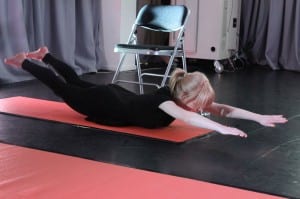
Performer: Kayleigh Newberry |
Cartwheel Lift ‘Sustain’ Studio X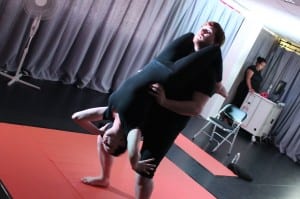
Performers: Chelsea Simpson and Rory Butler |
| Left-Hand Sustained Lift ‘Sustain’ Studio X |
Works Cited
Gleave, J. (2011) The Reciprocal Process of The Site and The Subject in Devising Site-Specific Performance. MPhil(b). University of Birmingham.
Hill, L. (2006) (Dis)Placing the Senses: Introduction. In: Leslie Hill & Helen Paris (ed.) Performance and Place. Basingstoke: Palgrave Macmillan, 47-48.
La Frenais, R. (2006) An Introduction to Vertigo. In: Leslie Hill & Helen Paris (ed.) Performance and Place. Basingstoke: Palgrave Macmillan, 53.
Pearson, M. (2010) Site-Specific Performance. Basingstoke: Palgrave Macmillan.
Reference List
Govan, M. (n/a) The Place of The Artist. [online] Available: http://blackboard.lincoln.ac.uk/bbcswebdav/pid-768813-dt-content-rid-1342791_2/courses/DRA2035M-1314/govan%20revisioning%20place.pdf [Accessed 8 May 2014].
Kaye, N. (2000) Site-Specific Art Performance, Place and Documentation. Oxon: Routledge.
Slowiak, J. (2007) Jerzy Grotowski. London: Routledge.
